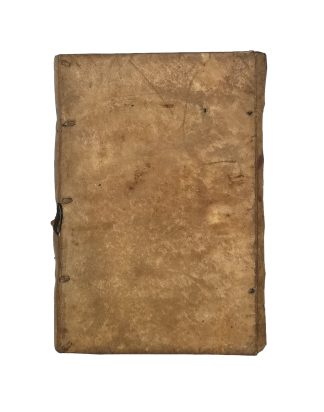CASTIGLIONE, Baldassarre.
Il libro del Cortegiano
Venice, Aldo Manuzio, 1547£2,950.00
8vo, ff. (v) 195 (viii). Italic letter, occasional Roman. Large Aldine device within ornate border with putti, cornucopiae and masks to title page and verso of last. Slight age yellowing in places, rare marginal spot or finger mark, light waterstains at gutter of last gatherings. A good, clean, wide margined copy in contemporary limp vellum, probably English, yapp edges, covers a bit soiled, lacking ties. Two holes on spine revealing early printed book page used in binding, inked ms. title, a.e.g. C20 armorial bookplate ‘Boothe’ on front pastedown.
Providing a correct text revised from the original manuscripts, and including three final indexes for the first time, this is the most complete and refined edition of ‘Il libro del Cortegiano’ by the Aldine press.
Baldassarre Castiglione (1478-1529) studied ‘literae humaniores’ in Milan and served the Sforza and Gonzaga before moving to the court of the Duke of Urbino. ‘Il Cortegiano’, his masterpiece, is structured as a series of conversations that allegedly took place there, in one of the most elegant courts of Italy, over four nights in 1507, when Castiglione was a member of the Duke’s Court. The philosophical dialogues are concerned with describing what constitutes the ideal courtier and – in the third book – the ideal court lady, worthy to befriend and advise a Prince or political leader. Nobility, wit, honesty, temperance and magnanimity are among the virtues that the perfect courtier should have, but he should also be well educated in Latin and Greek, skilled in dancing, fencing, painting and playing music. Above all qualities, however, Castiglione stresses the importance of oratory and clarity of speech: taking inspiration from Cicero and Quintilian, the perfect courtier should adapt his speech to the audience, be proficient in foreign languages such as French and Spanish, and be able to impress with his culture and sense of humour. Finally, the courtier should apply ‘sprezzatura’ to everything he does, that is a certain ‘nonchalance’ or ability to present what is done and said as if it was done without any effort. “The courtier depicts the ideal aristocrat, and it has remained the perfect definition of a gentleman ever since. It is an epitome of the highest moral and social ideas of the Italian Renaissance” (PMM 59)
With over 120 editions printed in the span of a century, and translated in English, French, Spanish, German and Latin within only 40 years from the princeps of 1528, Il libro del Cortegiano was the most successful Italian book in Europe during the XVI century. The enormous popularity of pocket-size editions, such as this, evidences the habit of bringing this book of manners along and consulting it. The final indexes include a list of the most remarkable subjects and a summary of the qualities required by ideal courtiers and ladies. Specific qualities listed for court ladies are kindness, affability with men, strength of character and beauty. “It seems reasonable to argue that the rise of the learned lady in Italy between 1540 and 1560 shows the influence of Castiglione’s dialogue […] in contrast to tradition, Castiglione presents ladies in a role other than that of mother, daughter or wife” (Burke).
‘Cette edition très jolie, revue avec soin, et la première qui ait un Index, me semble la meilleure quel les Alde aient donnée de ce livre …’. Renouard, p. 140. USTC 819507; BM STC It. p. 156; Adams C933; Renouard, 139:1; Graesse II p. 66; see Gamba 294 (of 1st ed.). See also: Printing and the Mind of Man, 59 (of 1st ed.); S.W. Hull, Chaste, Silent and Obedient, English books for Women 1475-1640, p. 156 (1982); A. Erdmann, My Gracious Silence, Women in the Mirror of 16th century printing in Western Europe, n. 33, p. 35 (1999); P. Burke, The fortunes of the ‘Courtier’, p. 50 (1995).In stock







